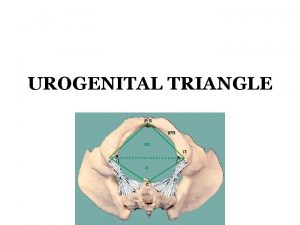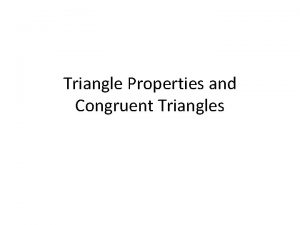Chapter 06 The triangle and its properties 03










- Slides: 10

Chapter – 06 The triangle and its properties - 03 05 -11 -2020 Thursday

Two special angles: Equilateral triangle : A triangle in which all the three sides are of equal length is called an EQUILATERAL triangle. A 5 cm AB = BC = CA = 5 cm B C 5 cm Isosceles Triangle : A triangle in which two sides are of equal length is called ISOSCELES triangle. Base angles opp to the equal sides are equal. A 4 cm B 4 cm 2 cm C AB = AC = 4 cm

Right Angled Tringle And PYTHAGORAS property : Statement : In a right angled triangle, The square on the HYPOTENUSE = SUM OF THE SQUARES ON THE LEGS. A 2 Hypotenuse Height B Base C Note : If the Pythagoras property holds, the triangle must be right angle. 2 2 AC = BC + AB

Exercise 6. 5 Solution 1 : By the rule of Pythagoras Theorem, { Pythagoras theorem states that for any right angled triangle, the area of the square on the hypotenuse is equal to the sum of the areas of square on the legs. } In the above figure RQ is the hypotenuse, QR 2 = PQ 2 + PR 2 QR 2 = 102 + 242 Q QR 2 = 100 + 576 QR 2 = 676 QR = √ 676 QR = 26 cm p R Hence, the length of the hypotenuse QR = 26 cm. Solve in fair note

Solution 2 : By the rule of Pythagoras Theorem, A In the above figure RQ is the hypotenuse, AB 2 = AC 2 + BC 2 252 = 72 + BC 2 7 cm 25 cm 625 = 49 + BC 2 C B By transposing 49 from RHS to LHS it becomes – 49 ? BC 2 = 625 – 49 BC 2 = 576 BC = √ 576 BC = 24 cm Hence, the length of the BC = 24 cm.

Solution 3 : By the rule of Pythagoras Theorem, In the above figure RQ is the hypotenuse, 152 = 122 + a 2 225 = 144 + a 2 By transposing 144 from RHS to LHS it becomes – 144 a 2 = 225 – 144 a 2 = 81 a = √ 81= 9 m Hence, the length of a = 9 m. Solution 4 : (i) Let a = 2. 5 cm, b = 6. 5 cm, c = 6 cm Let us assume the largest value is the hypotenuse side i. e. b = 6. 5 cm. Then, by Pythagoras theorem, b 2 = a 2 + c 2 6. 52 = 2. 52 + 62 42. 25 = 6. 25 + 36 42. 25 = 42. 25 The sum of square of two side of triangle is equal to the square of third side, ∴The given triangle is right-angled triangle. Right angle lies on the opposite of the greater side 6. 5 cm.

(ii) Let a = 2 cm, b = 2 cm, c = 5 cm Let us assume the largest value is the hypotenuse side i. e. c = 5 cm. Then, by Pythagoras theorem, c 2 = a 2 + b 2 52 = 22 + 22 25 = 4 + 4 25 ≠ 8 The sum of square of two side of triangle is not equal to the square of third side, ∴The given triangle is not right-angled triangle. (iii) Let a = 1. 5 cm, b = 2 cm, c = 2. 5 cm Let us assume the largest value is the hypotenuse side i. e. b = 2. 5 cm. Then, by Pythagoras theorem, b 2 = a 2 + c 2 2. 52 = 1. 52 + 22 6. 25 = 2. 25 + 4 6. 25 = 6. 25 The sum of square of two side of triangle is equal to the square of third side, ∴The given triangle is right-angled triangle. Right angle lies on the opposite of the greater side 2. 5 cm.

Solution 5 : By observing the figure we came to conclude that right angle triangle is formed at A. From the rule of Pythagoras theorem, B BC 2 = AB 2 + AC 2 BC 2 = 52 + 122 BC 2 = 25 + 144 5 cm ? BC 2 = 169 BC = √ 169 A C BC = 13 m 12 cm Then, the original height of the tree = AB + BC = 5 + 13 = 18 m

Solution 7 : Let ABCD be the rectangular plot. Then, AB = 40 cm and AC = 41 cm A D BC =? According to Pythagoras theorem, From right angle triangle ABC, we have: 40 cm 41 cm 2 2 2 = AC = AB + BC = 412 = 402 + BC 2 = 412 – 402 B C = BC 2 = 1681 – 1600 ? = BC 2 = 81 = BC = √ 81 = BC = 9 cm Hence, the perimeter of the rectangle plot = 2 (length + breadth) Where, length = 40 cm, breadth = 9 cm Then, = 2(40 + 9) = 2 × 49 = 98 cm

Solution 8 : Let PQRS be a rhombus, all sides of rhombus has equal length and its diagonal PR and SQ are intersecting each other at a point O. Diagonals in rhombus bisect each other at 90 o. So, PO = (PR/2) = 16/2 = 8 cm And, SO = (SQ/2) = 30/2 = 15 cm Then, consider the triangle POS and apply the Pythagoras theorem, PS 2 = PO 2 + SO 2 PS 2 = 82 + 152 PS 2 = 64 + 225 PS 2 = 289 PS = √ 289 PS = 17 cm Hence, the length of side of rhombus is 17 cm Now, Perimeter of rhombus = 4 × side of the rhombus = 4 × 17 = 68 cm ∴ Perimeter of rhombus is 68 cm.
 Project
Project The emigree annotations
The emigree annotations Its halloween its halloween the moon is full and bright
Its halloween its halloween the moon is full and bright Matter and its properties
Matter and its properties Kite definition geometry
Kite definition geometry Difference between intensive and extensive properties
Difference between intensive and extensive properties Chemical property of matter
Chemical property of matter Calot's triangle boundaries
Calot's triangle boundaries When a train increases its velocity, its momentum
When a train increases its velocity, its momentum Weather sunny cloudy rainy windy
Weather sunny cloudy rainy windy If its square its a sonnet summary
If its square its a sonnet summary



















